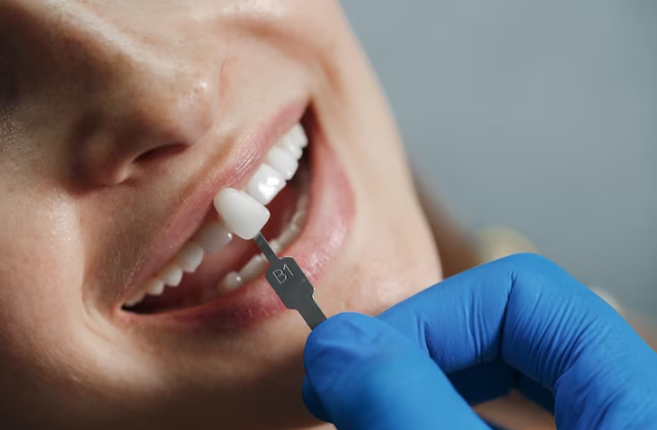Many of us at one point or another will need to get a filling for one of our teeth. In the past, metal fillings were usually used as they were durable and long-lasting. Today, more people are choosing ceramic tooth fillings as an alternative – and with good reason!
Not only do ceramic fillings look much more natural than metal ones in your mouth when you smile, but they’re also good for health reasons too. In this blog post we’ll be exploring why ceramic tooth fillings are becoming increasingly popular among patients everywhere!
At Keels Family & Cosmetic Dentistry, we prioritize your comfort and oral health. Proudly introducing our latest treatment option: Ceramic Fillings. Crafted from high-quality, tooth-colored materials, these fillings seamlessly blend with your natural teeth, offering a durable, aesthetically pleasing solution for cavities.
Step into a new era of dental care with us, and experience the exceptional advantages of ceramic fillings!
Ceramic Tooth Fillings Repair & Replacement
If you’ve got some dental problems like decay or damage, ceramic tooth fillings can come to the rescue! They’re also called porcelain fillings or dental ceramic inlays/onlays. They work their magic by fixing up your teeth and making them good as new.
Ceramic tooth fillings typically last a long time, but there are situations where repair or replacement may be necessary:
Damage or Wear: Like any dental restoration, ceramic fillings can experience wear and tear over time. Chewing on hard objects, teeth grinding (bruxism), or using your teeth as tools can lead to chipping or cracking of the filling.
Decay: If you start seeing more decay around the edges of your ceramic filling, it might be a good idea to get it fixed or swapped out. This will help avoid any additional harm to your tooth.
Dislodgment: In some cases, the ceramic filling may become loose or dislodged from the tooth due to weakened bonding or trauma. Get it repaired or replaced ASAP to avoid complications.
Fracture of the Tooth: If the tooth with the ceramic filling sustains a significant fracture, the filling may need replacement to restore the tooth’s functionality and aesthetics.
Aesthetics: Some patients may opt for the replacement of ceramic fillings if they desire a more cosmetic improvement or if the existing filling has become discolored or stained over time.
Allergic Reactions or Sensitivity: In rare cases, patients may develop allergies or sensitivities to the materials used in the ceramic filling. If this occurs, replacement with a different dental material may be necessary.
Size Limitations: In certain cases where the cavity is too extensive or involves multiple surfaces of the tooth, a ceramic filling may not be the most suitable option. In such situations, alternative treatments like dental crowns may be recommended.
If you have a ceramic tooth filling and experience any discomfort, notice damage, or have concerns about its appearance, it is essential to visit your dentist for an evaluation.
Getting regular dental check-ups is super important! They can help catch any problems with your dental restorations early on and take care of them right away. This not only helps keep your oral health in good shape but also makes sure that your fillings last for a long time.
At Keels Family & Cosmetic Dentistry, ceramic tooth fillings repair and replacement is more than a mere treatment. It’s a commitment to enhancing your oral health and boosting your confidence with a radiant, natural-looking smile.
Our highly skilled and experienced dental team utilizes top-of-the-line ceramic materials to craft fillings that not only replicate the natural look of your teeth but also provide outstanding durability.
Throughout the repair and replacement process, your comfort is our utmost priority. Our team ensures that the procedure is performed with minimal discomfort, using advanced techniques and the latest equipment.
We invite you to experience exceptional dental care in a friendly and soothing environment at our clinic.

Difference Between Ceramic & Composite Dental Fillings
Proper maintenance of clear aligners is crucial for the success of the treatment and overall oral health. Cleaning aligners is relatively simple. Here’s how to do it:
Cleaning aligners is an essential part of maintaining good oral hygiene during orthodontic treatment. Aligners, like Invisalign, are typically worn for several weeks, and proper cleaning ensures they remain clear, odor-free, and effective in shifting your teeth. Here’s a step-by-step guide on how to clean aligners:
- Remove the Aligners: Take out the aligners from your mouth. It’s important to remove them before cleaning to prevent any accidental damage.
- Rinse with Water: Rinse the aligners under lukewarm water immediately after removal. This helps to get rid of saliva and debris that may have accumulated on them during wear.
- Use a Soft Toothbrush: Gently brush the aligners using a soft-bristled toothbrush. Avoid using toothpaste, as it can be abrasive and may scratch the aligners, making them more visible. Instead, use a mild, clear, or antibacterial soap to clean them. Brush both the inside and outside surfaces of the aligners.
- Soak in a Cleaning Solution: You can use a commercial denture or retainer cleaning solution to soak the aligners. Alternatively, you can create a homemade cleaning solution by mixing equal parts of water and white vinegar. Avoid using colored or scented solutions, as they may stain or leave a residue on the aligners. Soak the aligners for about 20-30 minutes.
- Avoid Hot Water: Hot water can warp the aligners, so always use lukewarm or cool water when cleaning or rinsing them.
Maintaining proper oral hygiene during orthodontic treatment is crucial for achieving successful results and maintaining overall oral health. Always follow your orthodontist’s recommendations and guidelines for the best outcome.
Pricing
At Keels Family & Cosmetic Dentistry, we believe that high-quality dental care should be accessible and affordable. We strive to keep our pricing reasonable and competitive without compromising the standard of our services.
While the cost of dental fillings can vary depending on the complexity of the procedure and the materials used, we ensure transparency with our pricing from the outset. We provide detailed quotes during consultations, outlining potential costs so there are no surprises. We also accept a variety of payment methods and offer flexible financing options to help manage your dental health investment.
Can You Eat Solid Food After A Ceramic Dental Fillings?
After receiving a ceramic dental filling, it’s advised to wait until the numbness from the anesthesia has completely worn off before attempting to eat solid food. This precaution is essential to avoid accidentally biting the inside of your mouth or tongue. Once the numbness has subsided, you should be able to eat as normal.
How Long Does It Take To Fully Heal After A Ceramic Filling?
Healing time after a ceramic filling varies, with most patients fully healed within two weeks. Sensitivity to heat and cold may persist for a few days.
At Keels Family & Cosmetic Dentistry, we provide all necessary post-procedure guidance to expedite your healing process. Our team of professionals is always available to answer your queries, ensuring you’re comfortable and confident during recovery.
Plus, we offer follow-up appointments to monitor your progress and adjust treatment if necessary. We strive to not just restore your smile, but also to provide a seamless, worry-free healing experience.
How To Care For Your Ceramic Dental Filling
Caring for your ceramic dental filling is essential to ensure its longevity and maintain good oral health. Here are some tips to help you take care of your ceramic dental filling:
- Follow good oral hygiene practices: Brush your teeth at least twice a day with fluoride toothpaste and a soft-bristled toothbrush. Floss daily to remove plaque and debris from between your teeth and around the filling.
- Avoid hard and sticky foods: Ceramic fillings are durable, but they can still chip or crack if subjected to excessive force. Avoid biting down on hard objects like ice, pens, or fingernails, and be cautious with sticky candies or foods that could pull on the filling.
- Limit staining foods and drinks: Ceramic fillings are resistant to staining, but it’s still a good idea to limit your intake of foods and drinks that can cause discoloration, such as coffee, tea, red wine, and dark berries.
- Wear a mouthguard during physical activities: If you participate in sports or activities that could lead to dental injuries, wear a custom-fitted mouthguard to protect your teeth and fillings from potential damage.
- Avoid teeth grinding: If you have a habit of grinding or clenching your teeth, speak to your dentist about getting a night guard to protect your teeth and fillings while you sleep.
- Visit your dentist regularly: Schedule regular dental check-ups and cleanings with your dentist. They can monitor the condition of your filling and address any issues before they become more significant problems.
- Report any issues to your dentist: If you experience any discomfort, sensitivity, or notice changes in your filling, contact your dentist as soon as possible. Early intervention can help prevent further complications.
- Avoid smoking and excessive alcohol consumption: Smoking and excessive alcohol consumption can have negative effects on your oral health and may weaken the bonding of your dental filling.
- Consider a mouth rinse: Your dentist might recommend a fluoride mouth rinse to help strengthen your natural teeth and the surrounding areas of the filling.
Remember, the lifespan of your ceramic dental filling depends not only on the material but also on how well you care for it. By following these tips and maintaining good oral hygiene practices, you can extend the life of your dental filling and promote overall oral health.
Taking care of your ceramic dental filling is essential for maintaining its longevity and your overall oral health. At Keels Family & Cosmetic Dentistry, we provide tailored guidance on dental care post-treatment to ensure your filling stays in top shape. With us, preserving the health of your smile is a shared journey.
Are Ceramic Dental Fillings Permanent?
Ceramic dental fillings are known for their durability, often lasting for many years, even decades, with proper care. However, they are not considered permanent in the same way your natural teeth are.
Over time, wear and tear as well as lifestyle and dietary habits can impact their longevity. Regular dental check-ups at Keels Family & Cosmetic Dentistry will allow us to monitor the condition of your fillings and address any potential issues early.
Despite not being ‘permanent’, ceramic fillings are a long-term solution for maintaining oral health, and with good hygiene practices, they can serve you well for a significant period.
Call for Ceramic Fillings Today!
Don’t let dental concerns affect your smile and wellbeing. Schedule your appointment at Keels Family & Cosmetic Dentistry today! Our expert team is committed to providing you with top-notch dental care in a comfortable, friendly environment.
Whether you need a ceramic filling or just a regular check-up, we’ve got you covered. Book your visit now and embark on a journey towards a healthier, brighter smile.
Why Choose Keels Family & Cosmetic Dentistry?
Make An Appointment
At Keels Family & Cosmetic Dentistry, we understand that people choose our practice for a multitude of reasons. Our prime location offers convenience to our valued patients, making it easy to schedule appointments and prioritize their oral health. The trust and satisfaction of our patients, who often refer friends and family, have solidified our reputation as a professional and caring dental office within our community. Our comprehensive services range from cosmetic dentistry to dental care for the entire family, ensuring that we meet the unique needs of every member. We work with various dental insurance plans to make quality care accessible. With flexible scheduling, a warm and welcoming atmosphere, state-of-the-art technology, and a commitment to patient education, we aim to provide not just dental services but also a comfortable and personalized experience. At Keels Family & Cosmetic Dentistry, we prioritize the health and well-being of our patients above all else, fostering a strong personal connection with each individual who walks through our doors.



